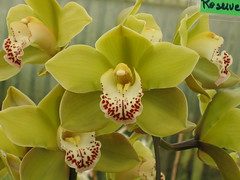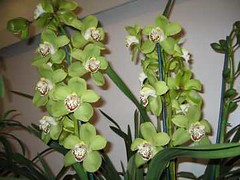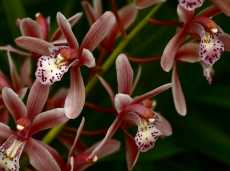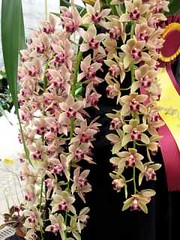A Cymbidium orchid is a great starter orchid to try your green thumb if you live in coastal California, New Zealand,
Australia, South Africa or the Mediterranean. Originally from a higher altitude in Central and Southeast Asia, and all the way to Australia, the standard Cymbidium enjoys a cool climate and strong light with partial shaded conditions. But the smaller-flowered terrestrial and tropical species live in different environments, so even if you do not have perfect Southern California weather, you can still grow these beauties. Let me tell you a little bit more about the different types of Cymbidium.
Cymbidium has retained its status as a celebrity orchid for thousands of years since the time of ancient China. Why do people love them so much? Cymbidium orchid hybrids produce up to 30 flamboyant and sometimes fragrant blooms on a single spike, and the flowers last couple of months. The Cymbidium I received for my birthday (boyfriend, here’s your acknowledgment!) in January still looked pristine in April. But wait, there’s more! Even if you cut those spikes and put them in a vase, the flowers will last just as long. No wonder Cymbidium is one of the most popular orchids for corsages. And even though there are only 44 species, thousands of hybrids have been developed to satisfy people’s demand for variety.
Standard Cymbidium Orchid
“Standard” Cymbidium refers to the large-flowered species from the Himalayas and China. These well-loved plants
produce large, attractive flowers that come in many different colors. The roundness of these flowers is a very desirable trait and commercial hybridizers work hard to develop plants that produce the fullest looking flowers. Even though they are tolerant of extreme temperatures, to thrive and to produce flowers, they require frost-free cool nights (below 53°F/12°C) and warms days. Cymbidium demands a little more fertilizer than most other orchids, so be sure to apply fertilizer twice a month at half the strength that is prescribed on the instruction label. You can also use the slow-release fertilizer once a year and forget about it for the rest of the year.American Orchid Society provides a good one-page free culture sheet on standard Cymbidium, so you can print one out as a reference.
Miniature and Compact Cymbidium Orchid
If your living environment does not accommodate a standard-sized Cymbidium, you should consider growing a
miniature or a compact Cymbidium. As a bonus, the flowers of these orchids are as showy as those of standard Cymbidium (two to three inches/five to eight centimeter wide) but are easier to bloom because they do not require a substantial chilling period to produce flower spikes. These Cymbidium will only grow to one to three feet tall and they bear up-right flower spikes with often fragrant flowers. These terrestrial orchids will flourish in an intermediate temperature year round.
Cascading Cymbidium Orchid
Cascading Cymbidium has stolen the spotlight for quite a number of years now. They are very compact and produce
smaller, yet profuse flowers. The cascading Cymbidium have pendent flower spikes that can reach up to 30 inches (76 centimeters) so you should grow them in hanging baskets or in a pot on a bench to maximize the stunning display. The flowers of the cascading Cymbidium could grow to be so dense that it totally covers the growing container. These floriferous (yes, that’s a real word) orchids do not require any chilling period; in fact, you should keep these tropical orchids continuously warm.
No matter which type of Cymbidium you are growing, keep in mind that these orchids like bright light (shaded from direct sun nonetheless). If your plant has weak and lifeless flower spikes and dark green leaves, it’s telling you that it needs more light. Also, at least once a month, flush the potting medium with fresh water with no fertilizer, so that the accumulated salt can be removed from the pot. If that is not done, you can see that the tips of the leaves will turn yellow and burnt.
Happy growing!




